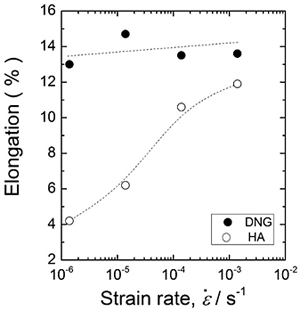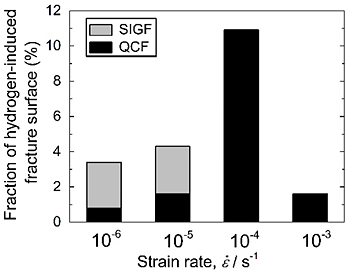Al-Zn-Mg-Cu alloys have been known to be sensitive to stress corrosion cracking arisen from hydrogen embrittlement. Suppression of hydrogen embrittlement is very important to develop new high strength aluminum alloys. In the present paper, hydrogen embrittlement sensitivity of Al-10Zn-2.6Mg-1.6Cu-0.2Cr alloy in T6 temper was evaluated by tensile testing at various strain rates in humid air (HA) and dry nitrogen gas (DNG).
Figure 1 shows the strain rate dependence of elongation to failure of the Al-10Zn-2.6Mg-1.6Cu-0.2Cr alloy. In DNG, the elongation does not depend on strain rate, while the elongation in HA decreases with decreasing of a strain rate due to hydrogen embrittlement. At slow strain rate, smooth intergranular fracture caused by hydrogen embrittlement was observed as shown in Fig. 2.
Figure 3 shows variation of the fraction of hydrogen-induced fracture surface in the specimens in HA. Quasi-cleavage fracture caused a loss of elongation at medium strain rates (10-4-10-3s-1), and smooth intergranular cracking degraded ductility at slow strain rates (10-6-10-5s-1). These results indicate that higher content of Zn in Al-Zn-Mg-Cu series alloy increase hydrogen embrittlement sensitivity, and exhibits hydrogen embrittlement even when the strain rate is 10-3s-1.


